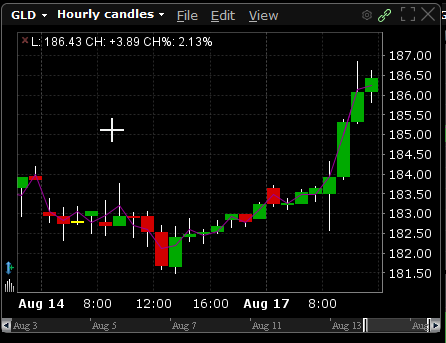GLD – A Proof of Concept Milking Rented Cows
This is an experiment I am making to determine in real life a theoretical premise: That by rolling frequently whenever a significant price movement on a stock occurs one can make more in premium income than one loses to friction. I've decided to run the test on one position the company holds on GLD, the ETF for Gold. I've chosen this ETF because it offers weekly options, and has relatively low bid/ask spreads, two prerequisites for this theory.
On Friday, August 14, we established a calendar spread, selling the AUG 21 182 puts, when the price was around 182. We collected $1.60 in premium. We bought an AUG 28 182 put, expiring 7 days later. This act as our hedge, capping our maximum loss to the $89 difference. The idea is to close the two positions by the time the shorter term position expires. Ideally, our AUG 21 short put should lose value at around $0.16 per day, accelerating towards the end of the week, while the AUG 28 put will lose value at around $0.11 per day.

On Monday, GLD moved up to 186.50. The combined positions were showing a $8.00 loss on a mark-to-market basis, as the AUG 28 puts lose more to the delta factor than the short puts gained. This was not a cause for concern, unless I were not to roll the puts. The idea is that I will be able to collect enough in premiums due to to theta decay to more than offset any loss on my longer term position.
We rolled the AUG 21 182 put to a $184 put as GLD rose to 186.50. We netted a $1.16 per share gain on the 182 put, and collected an additional $0.49 in cash flow.